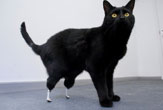Bionic Devices Let Injured Animals Roam Again

The artificial limb technology that has let disabled people walk again has been revolutionizing veterinary medicine in recent years.
For over a century, veterinarians had resorted to full-limb amputations for dogs, cats and other pets that had gravely injured portions of their legs. Such animals can get along alright using three out of their four appendages, but for those that have suffered trauma to multiple limbs, euthanasia had often been deemed the only humane option.
But no longer, thanks to the rise of creature-tailored prosthetics – devices that replace a missing or non-working body part – and orthotics, which brace damaged limbs. And while these implements improve the lives of thousands of animals, in some cases, progress with pets might lead to breakthroughs in rehabilitating people.
"Human doctors need to take notice," said Noel Fitzpatrick, a neuro-orthopedic veterinary surgeon based in the United Kingdom. "[Doctors] can get lot of information from veterinary patients for their own patients."
"One small step for a dog" can in fact end up as "one giant leap for mankind," Fitzpatrick said. [See the full article and gallery of animal prosthetics and orthotics.]
Hip to the latest tech
Several surgical procedures recently performed at Fitzpatrick's new £10million state-of-the-art clinic might bode well for human prosthetic patients someday.
Get the world’s most fascinating discoveries delivered straight to your inbox.
One operation involved Roly, an American bulldog who received a hip replacement in March. Stricken with cancer, the pooch had his femur and hip joint replaced with a device that allows tendons and musculature to innovatively grow into it.
Roly's promising new "tendon burger" arrangement could pave the way for successful tendon reattachments in human knees and shoulders following accidents, said Fitzpatrick, who performed the operation.
Pairing metal and bone
In another promising prosthetic development, Oscar the cat recently received two artificial rear feet that have made him the "first creature to our knowledge," Fitzpatrick said, to have bone- and skin-integrated implants placed in moving bone.
After a combine harvester severed both of Oscar's rear paws, the poor kitty underwent surgery in November 2009 at Fitzpatrick's clinic. The surgeon drilled holes in Oscar's remaining rear ankle bones and implanted titanium pegs called ITAPs (intraosseous transcutaneous amputation prosthetics).
Bone and skin mesh to the honeycomb-pattered ITAPS, with the bottom peg extruding through the skin much like a deer antler (which served as inspiration for the setup). After Oscar healed, special rubber-and-metal prosthetic paws were then simply screwed onto the exposed ITAP ends.
The hope is that Oscar's body will not reject the metal ITAPs and that the skin growing over and around them will seal out infections. Similar attempts to meld metal and bone have been made in humans and other animals but have not proven successful in the long run.
Getting a leg up
For the vast majority of animals, surgeries might be too expensive and risky, especially if only one limb is affected. Fortunately, non-surgical alternatives have also made great strides this last decade.
OrthoPets, for example, offers strap-on orthotics and prosthetics to brace or replace damaged limbs for a wide range of animals.
"All of our components, joints, straps and pads come from the human field but we have had to design and tweak them for our animal friends," said Amy Kaufman, who co-founded OrthoPets with her husband Martin in 2003.
A challenge with furnishing pets for artificial ambulatory devices is that unlike people, they do not speak up when a prosthetic or orthotic does not fit quite right. Accordingly, OrthoPets lines all its products with so-called diabetic foam – used by human diabetics who have lost sensation – that smudges black if it is experiencing too much pressure.
Lending a helping hand, fin or beak
Dogs and cats are not the only domesticated animals to have received prosthetics and orthotics. Though about 90 percent of OrthoPets' patients are dogs, with cats making up much of the remainder, the company has outfitted cows, alpacas, goats, sheep, horses, a llama and more.
Rescued animals have also been the beneficiaries of novel prosthetic and ability-restoring devices. For example, an American bald eagle named Beauty had half of her beak shot off by a hunter, and was found starving in Alaska four years ago. Since then, she has received a computer-modeled plastic replacement and a permanent titanium beak in the works.
In the water, a dolphin named Fuji at a Japanese aquarium now wears a special rubber-silicon synthetic tail fin created by the tire-making company Bridgestone.
An Atlantic sea turtle named Allison has been rigged up with a decidedly lower-tech, but effective solution. Tourists spotted Allison adrift, bloodied and missing three of her flippers, likely due to a predator attack. She was taken to Sea Turtle, Inc. a non-profit turtle rehabilitation organization in South Padre, Texas.
There, with her single front fin, she could swim only in counterclockwise circles. An intern named Tom Wilson had the idea to build a rudder-like single fin that would extend behind Allison. Sure enough, it allowed her to swim straight.
"We don't need to spend thousands of dollars on materials that just aren’t necessary . . . for animals, we need to look at what are the animals' needs," Wilson told TechNewsDaily. "Allison just needed a stick running down her back to stabilize her."



